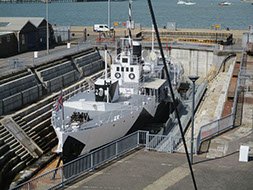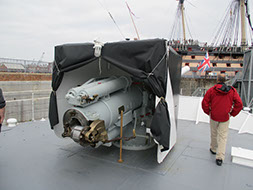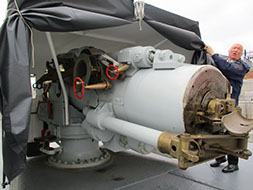Royal Navy monitor M.33



The M.29 class monitor M.33 was ordered from the Harland and Wolff shipyard in Belfast, Northern Ireland on March 15, 1915. However, the keel for M.33 was actually laid down on April 1, 1915 at the Workman and Company shipyard that was subcontracted by Harland and Wolff to build the ship. M.33 was launched on May 22, 1915 and commissioned on June 24, 1915. M.33 displaced 580 tons with a length of 177 feet, a beam of 31 feet with a crew of 72 officers and men. M.33’s armament consisted of two 6 inch Mk XII guns, one Hotchkiss 6 pounder high angle gun and three .30 cal. Maxim machine guns. M.33 in action.
M.33 in action.
Return to England
After a short shakedown cruise, M.33 departed Pembroke dock bound for Turkey on June 28, 1915, arriving at Mudros on July 24, 1915 and from there she was dispatched to the Dardanelles to support the Gallipoli campaign. M.33’s first action began on August 6, 1915 when she supported the 20,000 British troops landing at Suvla Bay. M.33 took up station off of Gabe Tepe and took under fire Turkish gun batteries, mobile artillery positions, and Turkish troop concentrations. Over the course of eight days, M.33 fired off almost all 400 rounds in her main battery magazines. Over the next five months, M.33’s duties included conducting patrols off the West coast of the Gallipoli peninsula, conducting a watch to report the possibility of a breakout into the Mediterranean of the battlecruiser Goeben and the light cruiser Breslau. Later M.33 was stationed off the Gulf of Smyrna engaged in blockading duties, shore bombardment, etc., until January 8, 1916, when the allied troops were withdrawn from Gallipoli. Later that year on September 1, 1916, M.33 participated in the capture of the Greek fleet at Salamis Bay. After the Gallipoli campaign, M.33 sailed west basing at the ports of Salonika and Stavros while engaged during the Bulgarian campaign. During this time she was also engaged in base protection duties.
After serving for more than three years in the Mediterranean, the original crew was finally relieved by a fresh crew on October 8, 1918. The new crew finished out the war and sailed M.33 back to England, finally returning to Chatham on April 10, 1919. M.33 was finally home but she did not linger very long in England.
To Russia
On May 11, 1919, M.33 was dispatched to Murmansk in Northern Russia as part of a large Royal Navy reinforcement squadron of 20 ships to support the British North Russian Expeditionary Force. M.33 arrived at Archangel on June 9 ,1919, and shortly after arriving there, M.33 was dispatched as part of a task force that sailed up the Dvina river for a three month deployment supporting British and White Russian forces. During this deployment the M.33 came under fire on many occasions, being struck by enemy shells at least five times. Eventually the force including the M.33 was tasked with covering the withdrawal of the British and White Russian forces. During the return trip down the Dvina, the river was so low that the M.33 grounded and after considerable effort which included the removal of the 6 inch guns and their ammunition which were transported down river by cart, the M.33 was finally re-floated and she returned to Archangel. M.33 was indeed fortunate to be able to return to Archangel however two larger monitors also went aground during the return voyage and had to be destroyed in order to avoid their capture. With her duty completed in Russia, M.33 finally returned to Chatham, England on October 18, 1919 and was subsequently decommissioned.
Between the wars.
In 1924, M.33 was taken in hand at Pembroke dock for conversion for the next chapter in her career. During the conversion process the 6 inch guns were removed and the ship was reconfigured for service as a mine-layer training ship and tender. Recommissioned on February 3, 1925, and renamed H.M.S. Minerva she was transferred to the mine warfare training school at H.M.S. Vernon at Portsmouth, England, serving there until 1936 when she was again decommissioned. Later that year the ship was recommissioned as a tender to H.M.S Effingham.
World War2
Just before the start of WWII in 1939, M.33 was decommissioned again and put up for sale but when WWII started, she began her service as a floating office which continued until 1943. In 1943 M.33 was transferred to White’s shipyard on the river Itchen for service as a floating boom defense workshop. It was here that the engines were dismantled and its funnel was removed. In 1944, M.33 was towed to the river Clyde for continued service.
Post World War 2.
In 1946, M.33 was returned to Portsmouth waters and was moored at Gosport, serving there as a workshop and offices until 1971. In 1984, M.33 was again put up for sale and shortly afterward she became part of the National Historic Fleet. 1987 saw the M.33 sold to the Hartlepool Ship Preservation Trust and she was then transported by barge to Hartlepool where the funnel was restored. In 1990, M.33 was purchased by the Hampshire County Council and one year later she was transported back to Portsmouth dockyard for the beginning of a 14 year restoration effort to restore the ship to its original condition. To fund this comprehensive restoration project, 2.4 million pounds was raised with 1.78 million pounds coming from the Heritage Lottery Fund. Shortly afterward ownership of M.33 was transferred to the National Museum of the Royal Navy.
Restoration.
In 1991 the forward 6 inch gun was installed; this gun having previously been mounted aboard the cruiser H.M.S Delhi. In 1997 the hull was made watertight. Between 2000 and 2006, the internal structural restoration work was undertaken and external fittings were installed. Many of these items were nonexistent and had to be fabricated from scratch. The after 6 inch gun came from the Chilean battleship Almirante Latorre’, formerly the Royal Navy battleship H.M.S. Canada, which was engaged in combat at the Battle of Jutland. During the Battle of Jutland, H.M.S. Canada’s 6 inch guns were in action firing at German destroyers at 19:11 hours and again at 19:25 hours on May 31, 1916. After Almirante Latorre’ was scrapped in Japan in 1959, the ships’ guns remained in storage in Chile. Later the Chilean Navy donated this 6 inch gun to the Royal Navy and generously transported it to England where it was restored and installed aboard M.33. In 2007 M.33 was painted in a dazzle anti-submarine pattern like that which she wore during WWI. Finally, on August 7, 2015, M.33 was opened to the public. M.33 may be visited for tours at the National Museum of the Royal Navy at the Portsmouth Historic Dockyard.
